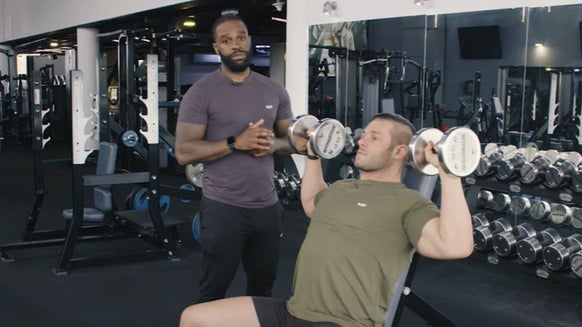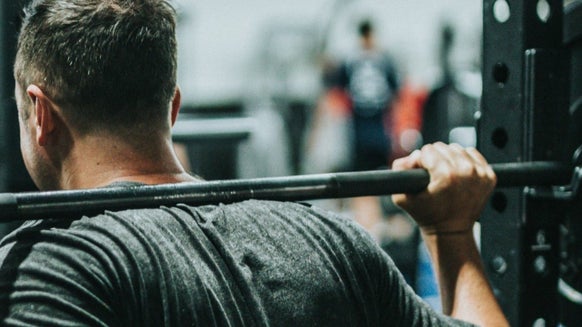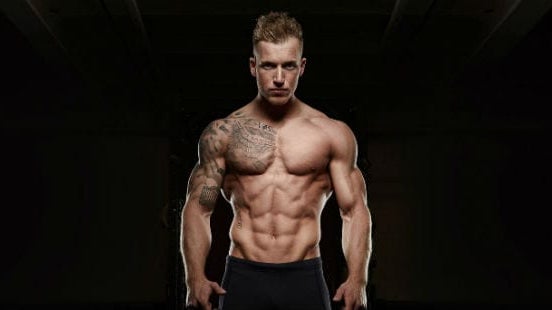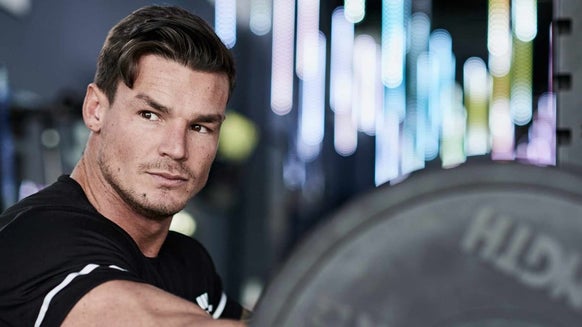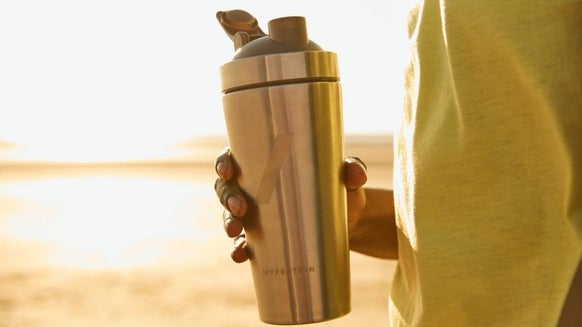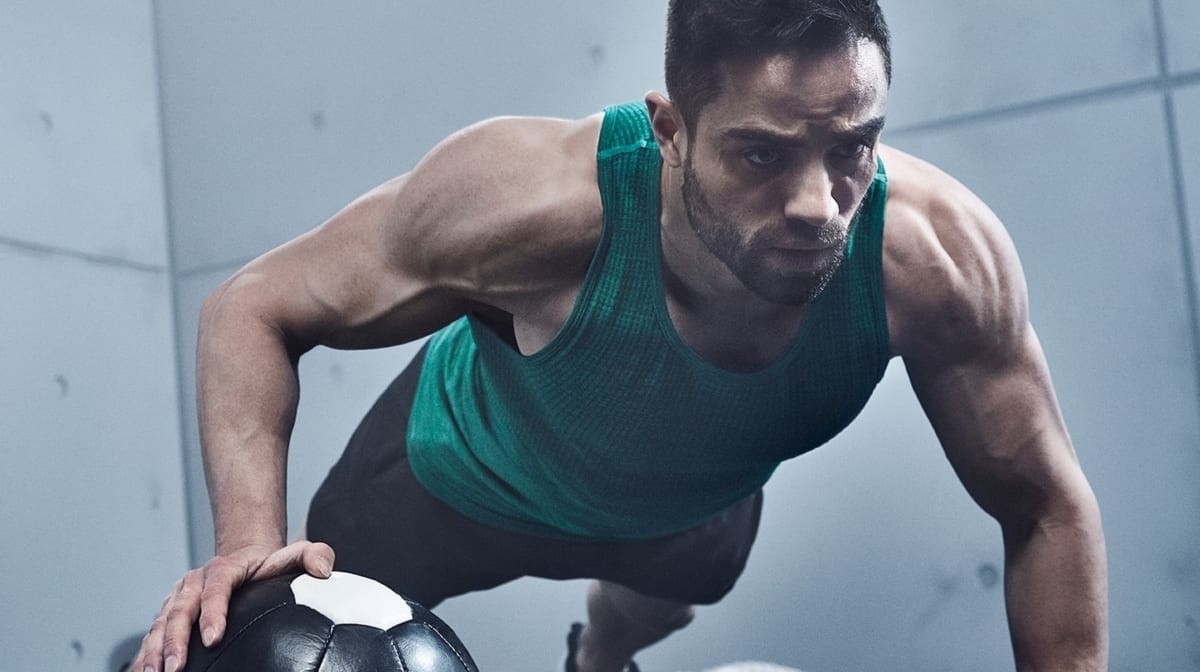
If you’re trying to improve aesthetics, then well‐developed shoulders are essential. Broad shoulders, combined with a wide back, help to give the illusion of a narrow waist. This is known as a V‐taper look — something that most people aspire to.
The trouble for most of us is finding time to workout when we don’t always have time for the gym. So, what’s the solution? Developing your shoulders from the comfort of your own home. We’re going to look at the best shoulder exercises and workouts for you to do at home — so you’ve got no excuses. Let’s get started.
Shoulder muscles:
The shoulders are commonly referred to as your delts (deltoids) and consist of three primary muscles — the front (anterior head), the side (lateral head), and the rear (posterior head).
The shoulders work in two motions. The first motion is a push, which includes exercises such as push‐ups, handstands, and bench or overhead presses. The second is when you lift something away from your body, that includes lifting in front, to the side of you, or even swinging your arms backwards. The direction of the movement determines which of the shoulder muscles are predominantly working.
Shoulder exercises using your body weight
There are many body-weight exercises that will directly, and indirectly, target your shoulder muscles. Body-weight exercises are perfect as they require very little equipment and can be completed from the comfort of your own home.
Any pressing movement like push‐ups will target the shoulders, chest, and triceps.
The angle of the exercise will determine which muscle is worked the most. To get your shoulder muscles working as hard as possible, you need to press vertically.
Push‐ups
The push‐up is often overlooked, but when done correctly is an excellent exercise for developing your shoulders. It also helps develop your arms, core, and chest.
How to do the push‐up – tutorial
https://youtu.be/_Luxy8rPzuU
1. Lie face down, with your palms on the floor, next to your shoulders. You can also use a bench.
2. Keeping your back straight, push your hands into the ground so that your torso lifts upwards off the floor. Make sure your hands, wrists, and elbows stay in a straight line throughout the movement.
3. At the top, hold this position for a second and then lower yourself back down to your starting position. Hold this for a second and then repeat the above steps.
4. Keep your core locked as tight as possible throughout.
5. Aim to complete 10 reps.
Decline push‐ups
By raising your feet on a bench, table or chair, you can still work your shoulders, but with more ease. The higher the position of your feet, the harder your shoulder muscles will work.
How to do decline push‐ups — tutorial
https://youtu.be/crht_vaWneA
1. Get into a push-up position and raise your feet onto a table or chair.
2. Keep your body and arms straight, palms on the floor, just wider than the shoulders.
3. Slowly lower yourself down to the floor whilst keeping your feet elevated.
4. Hold at the bottom for a second, then push back up. Repeat the sequence.
5. Start with 3 sets of as many reps as possible. Try build up the number of repetitions each week.
Handstand push‐ups
Okay, we know what you’re thinking — there’s no way I can do a handstand push‐up. They might look intimidating, and near impossible, but you actually don’t need to have superhuman strength to do them.
Handstand push‐ups are a skill that might take you a while to master. But, you’ll never know unless you try — so give them a go.
How to do handstand push‐ups — tutorial
https://youtu.be/t1fx2tAcamY
1. Do a handstand against a wall.
2. Straighten your legs and rest your feet against the wall.
3. Lower your head down to the floor by bending your elbows.
4. Hold your position at the bottom for a second and then push back up until your arms straighten up.
5. Rest at the top for a second and repeat.
6. Keep your core tight at all times
7. Start with 3 sets of as many repetitions as possible. Try to build up the number of reps you complete from week to week.
Avoid this shoulder‐exercise mistake
If you’re trying to put on mass we’d recommend you avoid doing too many circuits exercises, as they tend to have more of a conditioning effect. Rather than doing circuits, work on one specific exercise at a time with set reps in mind — focusing on maximal contraction to get the best effect for strength and growth. If you’re finding the exercise too easy, look for progression to make it harder and increase your muscle-building potential.
Dumbbell shoulder workout
Dumbbells are some of the best tools that you can use to develop your shoulders. They can be kept at home without taking up too much space and are extremely versatile — with so many exercises you can perform. Unlike body‐weight exercises, dumbbells also encourage you to use different plains of movement. Body weight exercises often limit shoulder movement to simply pushing, whereas dumbbells enable a more comprehensive range of movements in all directions.
Dumbbell overhead shoulder press
The dumbbell shoulder press exercise targets your shoulders, while placing some emphasis on your triceps and upper back. This is one of the best exercises to add mass to your upper body as it involves a multitude of muscles working together. The more muscles that are
involved the more weight can be lifted, which directly leads to muscle growth.
How to do dumbbell overhead shoulder press — tutorial
https://youtu.be/UXy79ivGwXY
1. Pick a suitable weight for your required number of reps. Raise each weight up and let the dumbbells sit on your shoulders (or just above them), with your palms facing forwards.
2. Push the weight up above your head and, still above your head, touch the dumbbells together. Next, lower the weight back down until the dumbbells are sitting back on your shoulders.
3. Make sure you do full repetitions — all of the way up and down. Repeat the steps for a suitable number of reps and sets.
4. To begin with, we recommend aiming for 3 sets of 8 to 12 reps.
Dumbbell front raise
The front raise strengthens primarily the shoulder (delts) but also works the upper chest muscles (pectorals). The dumbbell front raise should only be used if this part of your shoulder is lacking in size. The front of the shoulders will get worked a lot with pressing movements so be careful not to over-train this part of your body.
How to do Dumbbell front raise — tutorial
https://youtu.be/xvJnLIycpbk
1. Stand tall while holding a set of dumbbells against your thighs, and with your palms facing you.
2. Raise one dumbbell in front of you at a time, so that the dumbbell comes just above your shoulder‐line, parallel to the floor. Your arm should be almost straight, but your elbow soft, and your palms facing towards the floor. The opposite arm should be resting against your thigh.
3. Hold the dumbbell at the top of the movement for a second and slowly lower it back down. Next, raise your other arm and repeat the sequence.
4. Aim for 2 to 3 sets of 10 to 15 reps per arm.
Dumbbell side raise
The dumbbell side raise works the lateral head of the shoulders. This is the muscle on the side of the shoulder that when fully developed gives that 3‐D look and adds width to your physique. The exercise works the shoulder by lifting a dumbbell away from the body.
How to do dumbbell side raise — tutorial
https://youtu.be/2kLrHfLmUAA
1. Stand tall and grab a dumbbell in each hand, with your palms facing inwards, next to your thighs.
2. Lift your arms up to the side so that your knuckles are in line with your shoulders and your weights are parallel to the floor. Hold this position at the top for a second and slowly lower the weight back down to its starting position.
3. Make sure you keep your core tight and avoid swinging your hips to shift the weight.
4. Aim for 2 to 3 sets of 12 to 15 repetitions.
Bent over dumbbell raise
The bent over dumbbell raise works the posterior or rear shoulder head. The posterior head is responsible for giving that fully developed rounded look to the shoulders, and is often the most difficult to develop. This shoulder muscle is activated when lifting weight away from your body (shoulder abduction) but the body is bent over instead of being upright.
How to do Bent over dumbbell raise — tutorial
https://youtu.be/3QgieXH5fRQ
1. Stand up and lean your torso forwards towards the floor. Keep your lower back straight so that your torso is almost parallel to the floor. Keep your head in a neutral position and avoid extending your neck upwards.
2. Your arms should be down in front of you, dumbbells in hand, and palms facing each other. Make sure your elbows are relaxed, with a very slight bend, and not locked.
3. Engage your rear delts and pull your elbows up towards the ceiling in a reverse fly motion. The weights should end upwards, almost parallel to the floor, with your palms facing the floor.
4. Avoid bouncing your torso and relying on momentum. Instead, keep your core engaged throughout the movement.
5. Aim to complete 2 to 3 sets of 12 to 15 repetitions.
Take home message:
You don’t need any fancy equipment or a gym membership to effectively work your shoulders. If you incorporate these exercise into your regular workout routine, you should start to see noticeable improvements within weeks.
Just remember to focus on optimal form, with a full range of motion, to ensure your shoulder muscles are worked and strengthened correctly. Once you are familiar with these exercises, start gradually increasing the number of reps to make the exercise harder.

Coach Grant is a sports nutritionist and certified strength coach. He has multiple postgraduate diplomas in nutrition and strength coaching as well as a Master’s degree in Sports and Exercise Nutrition, with a specific focus on protein.
Grant has worked in the fitness industry for well over a decade and has helped coach professional athletes and sports teams, as well as the average gym-goer looking to get in the best shape possible. He now spends most of his working time teaching fitness professionals and coaching people remotely.
He’s a big believer in practising what he preaches and has been involved in resistance training and martial arts for over 20 years. In his spare time, Grant enjoys being with his wife and daughter as well as the family dogs and catching up on the latest Netflix series.
Find out more about Grant’s experience here and about his personal training here.



